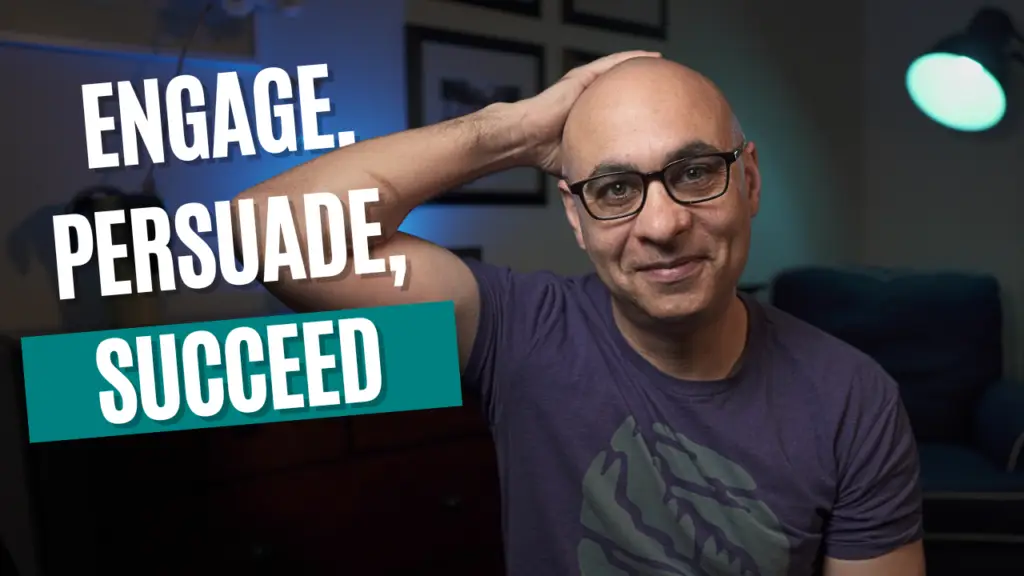Hey Team,
Pitching — whether it’s an idea, a product, or ourselves — can often feel like a high-stakes game where the pressure to perform meets the fear of rejection head-on. Yet, it’s a skill that, when honed, can open doors, create opportunities, and catalyze success. In my latest video, “Secrets to Pitch Anything (or Yourself) Better,” I delve into the things I’ve learned and done over the year — the tactics and mindsets that transform pitching from daunting to doable. But there’s more to it. Let’s dive deeper.
Understanding Your Audience: It’s Not About You
The first step to a successful pitch is shifting the focus from what we want to say to what the audience needs to hear. True engagement begins when we see our pitches through their eyes, understanding their challenges, aspirations, and the specific value they seek. Sometimes it’s hard — sometimes you have to leg go of something you really want to talk about because you realize it’s just not important to your audience — but being willing to adjust is critical.
The Power of Personalization and Connection
Making your pitch resonate requires a personal touch. It’s about showing your audience that you’re not just offering a product or an idea but a solution tailored to their unique needs. This connection is the bridge between interest and investment. Personalization can come in many forms: it can be as simple as adjusting the colors or logos in a demo, or making sure you use references or stories of people who are solving similar problems. No matter what you do, the goal is to remove friction. Anytime your audience has to connect the dots themselves – to envision whatever your pitching “working” for them, they are taken out of your story. That type of friction is easy to avoid – so long as you put in the effort.
Crafting Your Story: The Narrative Edge
Our brains are wired for stories. They’re how we make sense of the world, and they stick with us far longer than facts and figures. A compelling narrative that illustrates the journey from problem to solution can make your pitch unforgettable. If you’re demoing, selling something or yourself, find ways to turn the list of features or benefits into a relatable story; something where the audience can see themselves achieving something, or performing better. Even better yet, make sure your story is focused on the value they will realize.
Bringing Value to the Forefront
Rather than focusing on features (or skills if you’re in an interview), every bullet point in your presentation should tie back to the tangible value it brings to your audience. It’s not about what your product does, or what you know, but how it makes their lives easier, their work more effective, and their goals more attainable.
Incorporating Your Personality: The Secret Sauce
Authenticity wins. Letting your personality shine through not only makes your pitch more engaging but also builds trust. People do business with people they like and remember. Don’t be afraid to have a little fun and to be yourself. It may be hard at first, but remember, your pitching ideas, and telling stories every single day — to family and friends. Find a way to tap into the same passion and authenticity you have in your regular life and you’ll immediate notice the impact and improved response to any pitch.
Adaptability: The Art of Real-Time Customization
Being prepared is crucial, but so is being flexible. Listening and adapting your pitch in real-time shows that you’re truly attentive to your audience’s needs, not just ticking boxes on your presentation checklist. Sometimes it’s not possible — like when you’re on stage doing a 2 minute pitch competition, but most of the time that’s not what you’re doing. Watch for cues, ask questions and adapt as needed.
Tech Tips for a Digital Age
In a world where much of our pitching is done virtually, your on-camera presence and audio quality can significantly impact your audience’s experience. Investing in a good setup can set you apart and make your message clearer and more professional.
Remember:
The secret to pitching effectively lies in understanding that it’s a blend of science and art — knowing your audience, personalizing your approach, crafting a story, highlighting value, infusing your personality, and being adaptable. And in our increasingly digital world, how you present yourself online is just as important as what you present.
As you refine your pitching skills, remember that every pitch is an opportunity to learn and grow. I’d love to hear about your experiences and the strategies that have worked for you. Share your thoughts and stories in the comments below, and let’s continue to learn from each other.

